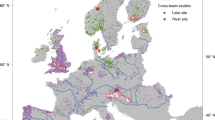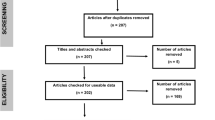Abstract
Published research is reviewed to provide examples of both positive and negative interactions of contaminants and: climate change; habitat change; invasive and introduced species; and, eutrophication including harmful algal blooms. None of these stressor interactions results solely in negative effects. Research must shift from examining contaminants or other stressors in isolation to considering potential positive and negative effects of interactions, with the ultimate goal of providing the necessary information for the effective management of ecosystem services.
Similar content being viewed by others
References
Anderson JC, Park BJ, Palace VP (2016) Microplastics in aquatic environments: Implications for Canadian ecosystems. Environ Pollut 218:269–280
Bielen A, Bošnjak I, Sepčić K, Jaklič M, Cvitanić M, Lušić J, Lajtner J, Simčič T, Hudina S (2016) Differences in tolerance to anthropogenic stress between invasive and native bivalves. Sci Total Environ 543:449–459
Briggs JC (2017) Rise of invasive denialism? A response to Russell and Blackburn. Trends Ecol Evol 32(4):231–232
Brooks BW, Lazorchak JM, Howard MDA, Johnson M-VV, Morton SL, Perkins DAK, Reavie ED, Scott GI, Smith SA, Steeven JA (2017) In some places, in some cases, and at some times, harmful algal blooms are the greatest threat to inland water quality. Environ Toxicol Chem 36(5):1125–1127
Campbell AL, Mangan S, Ellis RP, Lewis C (2014) Ocean acidification increases copper toxicity to the early life history stages of the polychaete Arenicola marina in artificial seawater. Environ Sci Technol 48:9745–9753
Chakraborty R, Wu CH, Hazen TC (2012) Systems biology approach to bioremediation. Curr Opin Biotechnol 23:483–490
Chapman PM (2008) Environmental risks of inorganic metals and metalloids: a continuing, evolving scientific odyssey. Hum Ecol Risk Assess 14:5–40
Chapman PM (2011) Global climate change means never going home again. Mar Pollut Bull 62:2269–2270
Chapman PM (2012a) Adaptive monitoring based on ecosystem services. Sci Total Environ 415:55–60
Chapman PM (2012b) Management of coastal lagoons under climate change. Estuar Coast Shelf Sci 110:32–35
Chapman PM (2016a) Assessing and managing stressors in a changing marine environment. Mar Pollut Bull. https://doi.org/10.1016/j.marpolbul.2016.10.039
Chapman PM (2016b) Toxicity delayed in cold freshwaters? J Great Lakes Res 42:286–289
Chapman PM (2016c) Benefits of invasive species. Mar Pollut Bull 107:1–2
Chapman PM (2016d) Sediment contaminant bioaccumulation: with or without gut contents? Bull Environ Contam Toxicol 97:151–152
Cheng FY, Basu NB (2017) Biogeochemical hotspots: Role of small water bodies in landscape nutrient processing. Water Resour Res 53(6):5038–5056. https://doi.org/10.1002/2016WR020102
Coppola F, Almeida Â, Henriques B, Soares AMVM., Figueira E, Pereira E, Freitas R (2017) Biochemical impacts of Hg in Mytilus galloprovincialis under present and predicted warming scenarios. Sci Total Environ 601–602:1129–1138
Daly GC, Matson PA (2008) Ecosystem services: from theory to implementation. Proc Natl Acad Sci USA 105:9455–9456
De La Riva D, Hladun KR, Vindiola B, Trumble JT (2017) Arthropod communities in a selenium-contaminated habitat with a focus on ant species. Environ Pollut 220:234–241
Dodds WK, Bouska WW, Eitzmann JL, Pilger TJ, Pitts KL, Riley AJ, Schloesser JT, Thornbrugh DJ (2009) Eutrophication of U.S. freshwaters: analysis of potential economic damages. Environ Sci Technol 43:12–19
Duchet C, Caquet T, Franquet E, Lagneau C, Lagadic L (2010) Influence of environmental factors on the response of a natural population of Daphnia magna (Crustacea: Cladocera) to spinosad and Bacillus thuringiensis israelensis in Mediterranean coastal wetlands. Environ Pollut 158:1825–1833
Dugan HA, Bartlett SL, Burke SM, Doubek JP, Krivak-Tetley FE, Skaff NK, Summers JC, Farrell KJ, McCullough IM, Morales-Williams AM, Roberts DC, Ouyang Z, Scordo F, Handon PC, Weathers KC (2017) Salting our freshwater lakes. PNAS 114(17):4453–4458
Freitas R, de Marchi L, Moreira A, Pestana JLT, Wrona FJ, Figueira E, Soares AMVM. (2017) Physiological and biochemical impacts induced by mercury pollution and seawater acidification in Hediste diversicolor. Sci Total Environ 595:691–701
Goldstein MC, Rosenberg M, Cheng L (2012) Increased oceanic microplastic debris enhances oviposition in an endemic pelagic insect. Biol Lett 8:817–820
Hemme CL, Deng Y, Gentry TJ, Fields MW, Wu L, Barua S, Barry K, Tringe SG, Watson DB, He Z, Hazen TC, Tiedje JM, Rubin EM, Zhou J (2010) Metagenomic insights into evolution of a heavy-metal contaminated groundwater microbial community. ISME J 4:660–672
Jacobson GL, Norton SA, Grimm EC, Edgar T (2012) Changing climate and sea level alter Hg mobility in Lake Tulane, Florida. Environ Sci Technol 46: 11710–11717
Jayasundara N, Fernando PW, Osterberg JS, Cammen KM, Schultz TF, Di Giulio RT (2017) Cost of tolerance: physiological consequences of evolved resistance to inhabit a polluted environment in teleost fish Fundulus heteroclitus. Environ Sci Technol 51:8763–8772
Kimberly DA, Salice CJ (2013) Interactive effects of contaminants and climate-related stressors: high temperature increases sensitivity to cadmium. Environ Toxicol Chem 32:1337–1343
Kinnison MT, Hairston NG (2007) Eco-evolutionary conservation biology: contemporary evolution and the dynamics of persistence. Funct Ecol 21:444–454
Laetz CA, Baldwin DH, Hebert VR, Stark JD, Scholz NL (2014) Elevated temperatures increase the toxicity of pesticide mixtures to juvenile coho salmon. Aquat Toxicol 146:38–44
LeMonte JJ, Stuckey JW, Sanchez JZ, Tappero R, Rinklebe J, Sparks DL (2017) Sea level rise induced arsenic release from historically contaminated soils. Environ Sci Technol 51:5913–5922
Li J, Li R, Li J (2017) Current research scenario for microcystins biodegradation: a review on fundamental knowledge, application prospects and challenges. Sci Total Environ 595:615–632
Little AG, Seebacher F (2015) Temperature determines toxicity: Bisphenol A reduces thermal tolerance in fish. Environ Pollut 197:84–89
Liu J, Wang W-X (2017) The protective roles of TiO2 nanoparticles against UV-B toxicity in Daphnia magna. Sci Total Environ 593–594:47–53
Long ER, Chapman PM (1985) A sediment quality triad: measures of sediment contamination, toxicity and infaunal community composition in Puget Sound. Mar Poll Bull 16:405–415
MacDougall AS, Turkington R (2005) Are invasive species the drivers or passengers of change in degraded systems? Ecology 86:42–55
Maceda-Veiga A, Mac Nally R, de Sostoa A (2017) The presence of non-native species is not associated with native fish sensitivity to water pollution in greatly hydrologically altered rivers. Sci Total Environ 607–608:549–557
McKenzie LA, Brooks R, Johnston EL (2011) Heritable pollution tolerance in a marine invader. Environ Res 111(7):926–932
McKinney MA, Atwood TC, Pedro S, Peacock E (2017) Ecological change drives a decline in mercury concentrations in southern Beaufort Sea polar bears. Environ Sci Technol 51:7814–7822
Menezes-Oliveira VB, Scott-Fordsmand JJ, Soares AMVM., Amorim MJB (2014) Development of ecosystems to climate change and the interaction with pollution: unpredictable changes in community structures. Appl Soil Ecol 75:24–32
Ng CA, Berg MB, Jude DJ, Janssen J, Charlebois PM, Amaral LAN, Gray KA (2008) Chemical amplification in an invaded food web: seasonality and ontogeny in a high-biomass, low-diversity ecosystem. Environ Toxicol Chem 27(10):2186–2195
Ochoa-Hueso R, Munzi S, Alonso R, Arróniz-Crespo M, Avila A, Bermejo V, Bobbink R, Branquinho C, Concostrina-Zubiri L, Cruz C, de Carvalho RC, De Marco A, Dias T, Elustondo D, Elvira S, Estébanez B, Fusaro L, Gerosa G, Izquieta-Rojano S. Lo Cascio M, Marzuoli R, Matos P, Mereu S, Merino J, Morillas L, Nunes A, Paoletti E, Paoli L, Pinho P, Rogers IB, Santos A, Sicard P, Stevens CJ, Theobald MR (2017) Ecological impacts of atmospheric pollution and interactions with climate change in terrestrial ecosystems of the Mediterranean Basin: current research and future directions. Environ Pollut 227:194–206
Passarelli MC, Riba I, Cesar A, Serrano-Bernando F, DelValls TA (2017) Assessing the influence of ocean acidification to marine amphipods: a comparative study. Sci Total Environ 595:759–768
Pedrosa J, Campos D, Cocchiararo B, Nowak C, Soares AMVM., Barata C, Pestana JLT (2017) Evolutionary consequences of historical metal contamination for natural populations of Chironomus riparius (Diptera: Chironomidae). Ecotoxicology 26:534–546
Peng J, Wang J, Cai L (2017) Current understanding of microplastics in the environment: occurrence, fate, risks, and what we should do. Integr Environ Assess Manage 13(3):476–482
Polasky S, Carpenter SR, Folke C, Keeler B (2011) Decision-making under great uncertainty: environmental management in an era of global change. Trends Ecol Evol 26(8):398–404
Ruddiman WF, Ellis EC, Kaplan JO, Fuller DQ (2015) Defining the epoch we live in: Is a formally designated Anthropocene a good idea? Science 348:38–39
Rudman SM, Kreitzman M, Chan KMA, Schluter D (2017) Ecosystem services: rapid evolution and the provision of ecosystem services. Trends Ecol Evol 32(6):403–415
Shrestha NK, Du X, Wang J (2017) Assessing climate change impacts on fresh water resources of the Athabasca River basin, Canada. Sci Total Environ 601–602:425–440
Sjerps RMA, ter Laak TL, Zwolsman GJJG. (2017) Projected impact of climate change and chemical emissions on the water quality of the European rivers Rhine and Meuse: a drinking water perspective. Sci Total Environ 601–602:1682–1694
Tassin J, Thompson K, Carroll SP, Thomas CD (2017) Determining whether the impacts of introduced species are negative cannot be based solely on science: a response to Russell and Blackburn. Trends Ecol Evol 32(4):230–231
Varó I, Redón S, Garcia-Roger EM, Amat F, Guinot D, Serrano R, Navarro JC (2015) Aquatic pollution may favor the success of the invasive species A. franciscana. Aquat Toxicol 161:208–220
Wagner M, Scherer C, Alvarez-Muñoz D, Brennholt N, Bourrain X, Buchinger S, Fries E, Grosbois C, Klasmeier J, Marti T, Rodriguez-Mozax S, Urtbatzha R, Vethaak AD, Winther-Nielsen M, Reifferscheid G (2014) Microplastics in freshwater systems: what we know and what we need to know. Environ Sci Eur 26(12):1–9. http://www.enveurope.com/content/26/1/12
Wang Z, Wang Y, Zhao P, Chen L, Yan C, Yan Y, Chi Q (2015) Metal release from contaminated coastal sediments under changing pH conditions: implications for metal mobilization in acidified oceans. Mar Pollut Bull 101:707–715
Woch MW, Stefanowicz AM, Stanek M (2017) Waste heaps left by historical Zn–Pb ore mining are hotspots of species diversity of beech forest understory vegetation. Sci Total Environ 599–600:32–41
Acknowledgements
I thank Erin Bennett, Editor-in-Chief of Bulletin of Environmental Contamination and Toxicology, for encouraging me to write this paper. Editor-in-Chief comment: I would like to thank Dr. Wayne G. Landis (Institute of Environmental Toxicology, Huxley College of the Environment, Western Washington University) for preparing the Memoriam in this paper for Dr. Peter Chapman.
Author information
Authors and Affiliations
Additional information
In Memoriam: Peter M. Chapman Dr. Peter M. Chapman, author of this article, passed away on September 26, 2017. In a ground-breaking paper, Ed Long (Long and Chapman 1985) and he introduced the sediment quality triad. The sediment quality triad was one of the earliest examples of using a weight of evidence approach to the correspondence between chemical concentration and bioassay results to effects in infauna. The paper was a key in moving environmental toxicology from mere hazard assessment to an integration of exposure and effect for decision making that is the basis of ecological risk assessment. Dr. Chapman made important contributions to the study of metals in sediments and was a relentless advocate for the use of regression methods to describe exposure-response relationships. His interest in sediment toxicology continued throughout his career as evidenced by his recently published paper (Chapman 2016d) on when to either use or not use benthic organism gut contents to assess bioaccumulation. As a journal editor, he encouraged the publication of new methods, set up lively learned discourses, and was relentless in his search of accuracy and fairness. This paper illustrates those qualities.
Dr. Peter Michael Chapman is deceased.
Rights and permissions
About this article
Cite this article
Chapman, P.M. Negatives and Positives: Contaminants and Other Stressors in Aquatic Ecosystems. Bull Environ Contam Toxicol 100, 3–7 (2018). https://doi.org/10.1007/s00128-017-2229-9
Received:
Accepted:
Published:
Issue Date:
DOI: https://doi.org/10.1007/s00128-017-2229-9




